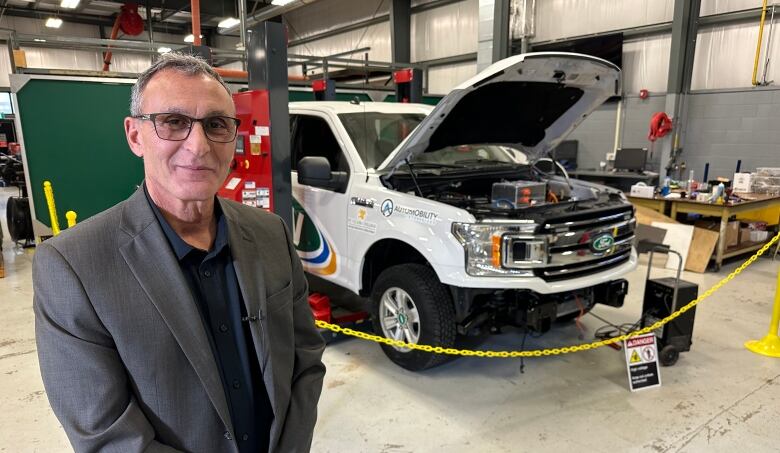This is the third in a three-part series, The Real Cost of Electric Vehicles, diving into the future of electric vehicles and how electrification will impact Windsor-Essex. On the first day, we looked at affordability. On the second day, we looked at environmental impacts.
For 23 years, Jayson Mercier has packed a meal, left his home and hit the road to go to work at the Windsor Assembly Plant.
The southwestern Ontario city’s biggest employer is about to go through some major changes as Stellantis, the company that owns the plant, makes big moves to electrify its automobiles. From a $4.9-billion investment to build a new electric vehicle (EV) battery plant and a $3.6-billion investment to retool both the Windsor and Brampton assembly plants for fully electric vehicles — times are changing.
“I’m optimistic. I know it’s gonna bring a tonne of jobs. I just hope that it transfers to my plant,” Mercier said this January afternoon as he prepared for his shift that day.
“We’ve been just kind of beat up so much in the last 20 years that … we’re looking forward to some gains.”
As an autoworker in Windsor, he’s been through layoffs and shutdowns, and the loss of the plant’s third shift.
When the battery plant was announced in March 2022, it promised to be the jolt of energy the local auto industry needed, particularly after the assembly plant was reduced to two shifts. There are promises that third shift is coming back, but as the city moves to electrify its vehicles, there are concerns there could also be a reduction in staff at the plant.
‘We’re going to be short’
In November, Reuters reported that at a conference in Detroit, Ford Motor Co. chief executive Jim Farley said electric vehicles would require 40 per cent less labour to build than current combustion vehicles.

The Local Unifor 444 president, Dave Cassidy, also anticipates a reduction.
“We’re going to be short,” he said.
He explained that at three full shifts with an ICE vehicle, the plant can employ 6,000 members, but that with the transition to battery electric vehicle assembly, while he doesn’t know for sure what the number of jobs would be, he predicts it might eventually go down to 3,500 to 3,800 jobs over the three shifts. Currently at two shifts, the plant employs about 4,000 workers.
“We don’t know what that negative loss is just in the assembly plant itself, not even talking, you know, about our feeder plants,” Cassidy said.
However, he added given that through the transition the assembly plant will be building multiple vehicles — including battery electric, hybrid and internal combustion engine vehicles — the assembly lines will need extra people “for some time.”
“You know my ultimate goal for that would be that we could have a group that could transition between the two facilities,” he said.
“When you become a member of our local, you’re here for life. So we are going to make sure that those people will have a future.”

Stellantis would not confirm whether there would actually be any reductions at the plant, but chief operating officer Mark Stewart said the goal is to have as many jobs as possible for people moving forward.
“We don’t have the great handle on it yet — as everybody is learning in the space about how many jobs it will be — but we want to make sure that we’d maximize that,” Stewart told CBC.

White-collar opportunities
While the assembly plant transforms with an impending announcement of the first new electric vehicle to be produced at the site, the battery plant, set to be operational by 2024, promises about 2,500 new jobs along with thousands of potential spinoffs.
There are already efforts at Invest Windsor-Essex (IWE) and Workforce Windsor-Essex (WFWE) to meet the moment of this transition.

“We’ve taken an approach of looking at how we can retrain existing workforce for those who want to transition into the EV supply chain. And we’ve also taken an approach of how we grow talent here locally to help feed whatever new occupations will come into the region,” said Matthew Johnson, director of mobility partnerships and innovation at IWE.
WFWE CEO Justin Falconer explained the organization has been working with local post-secondary schools and IWE to develop a new website to promote electric vehicle careers, announce new job opportunities and inform the public of education opportunities.
“We’re expecting … the creation of a lot of high-value, good-paying jobs in mechanical engineering, electrical engineering, even chemical engineering. So we’re going to see a lot more of that, and as the new factory gets built and the supply chain around it,” Falconer explained.
Schools charging up for EV future
At St. Clair College, the school will be launching an electric vehicle maintenance program this fall, recently approved by the Ministry of Colleges and Universities (MCU).

Waseem Habash, senior vice-president of academic and college operations at St. Clair, said they’ve been preparing for this transition for several years.
“We’re really excited because this puts Windsor on the map and it gives our graduates, the young generation, the next generation, the opportunity to have jobs for a long time,” Habash said.
At the University of Windsor, the school plans to offer a new mechatronics engineering program that would focus on manufacturing and producing electric vehicles. Once approved, the school says, it hopes to offer the program in the fall of 2024.

For young mechanical engineer Madeline McQueen, the electric vehicle movement is thrilling. She’s a research and development engineer with the university’s Centre for Hybrid Automotive Research and Green Energy (CHARGE) labs, with a focus on electric motor research.
“I think it’s really exciting as a young engineer, like stepping into my career at this time,” she said. “I see a field of opportunities.”
Cautious optimism
While there is some anxiety around the future, many autoworkers are optimistic about what it means to soon be building electric vehicles.
“The plant’s based on sales. If they sell, we’re good to go,” assembly plant worker Jason Rochon said.

“We’re pretty excited to see anything come in, and if it takes off, it’s another bonus for us, for the workers to try and get the third shift back,” assembly plant worker Paul Alford said.
For Mercier, considering the future can sometimes be “a little scary.”
“Uncertainty is probably what is the biggest issue with it all. There’s nothing set in stone, right?” he said.
While he’s cautiously optimistic, he said he trusts the union will always step up to the plate to support workers.
Cassidy is confident the changes will ultimately be good for workers across the map.
“I don’t think that there’s going to be winners and losers,” Cassidy said.
“It’s going to be a win-win out of this.”





More Stories
Fair share: the right office solution can take finding the right partner
Ontario faces crew shortages, aircraft issues in fight against wildfires | Globalnews.ca
Refugee attends open house at Downtown Eastside affordable housing facility – BC | Globalnews.ca